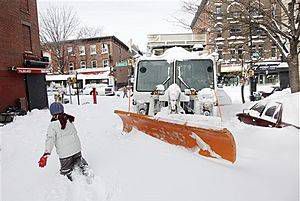
A girl walks past an abandoned snow plow, Monday, Dec. 27, 2010 in the Brooklyn borough of New York. A powerful East Coast blizzard menaced would-be travelers Monday. Two buses and two sanitation trucks were stuck on the same block in the Park Slope neighborhood of Brooklyn.
This winter has been an extreme one for major cities across the country, with even the most winter-savvy of cities having a hard time tackling the snow and ice.
New York City was virtually shut down after the blizzard that dumped 20 inches of snow on the city starting the day after Christmas. Atlanta is still struggling to recover from the snow and ice storm that hit earlier this week.
Even Minneapolis, a city well-equipped to handle brutal winter weather, has had problems.
So why is it that major U.S. cities have had such a tough time battling the snow this winter? In addition to the actual magnitude of the storms that have hit, preparedness and depth of resources, such as snow removal equipment and funds, play a role.
A winter storm that brought the South to a virtual standstill earlier this week dropped nearly 5 inches of snow in Atlanta and topped it off with a nasty layer of ice. While a storm like this would certainly create travel problems in big cities of the northern U.S., it would not have nearly the same impact as it does in the South.
Atlanta only has 10 pieces of snow equipment, according to the Atlanta Journal-Constitution, but commissioned additional vehicles to aid in snow removal, eventually bringing the total up to 58.
Compare these numbers to northern cities. Boston, while a smaller city by just more than 40 square miles, owns more than 500 snow removal vehicles, according to the City of Boston's website.
Likewise, Washington, D.C., is about half the area of Atlanta and owns 330 pieces of equipment, according to the city's website.

Broad Street stands covered in ice and snow in downtown Atlanta Tuesday, Jan. 11, 2011. A winter storm left many parts of Georgia crippled for a second day Tuesday, stranding Greyhound bus passengers in Atlanta without food and closing down government offices and school districts as roads remained coated in snow and ice. (AP Photo/David Goldman).
So in Atlanta's case, the main issue has been a lack of resources due to the city's geographic location being in an area that doesn't typically receive enough snow each winter to warrant a full fleet of snow removal equipment.
In addition to the manpower issue, the weather conditions in the South are only making matters worse, as temperature fluctuations are causing constant melting and refreezing, turning roadways and sidewalks into sheets of ice.
A combination of the magnitude of the blizzard and lack of preparedness, unfortunately, was New York's problem in late December.
A blizzard that dumps 20 inches of snow will cause massive disruptions to travel anywhere. But put that blizzard in New York, add in a lack of preparedness and effort on the part of snow removal crews, and you have a recipe for disaster.
The city is well-equipped to handle snow. According to the New York City Department of Sanitation annual report for 2009, the city had 365 salt spreaders, 295 front-end loaders (plows), 36 snow melters and 190 cut-downs (multi-purpose vehicles used for snow operations).
There have been allegations that city workers deliberately delayed snow removal efforts, leaving streets unplowed for three days in some places. Ambulances were unable to reach the sick and injured due to unplowed streets, and at least one baby died as a result, according to Bloomberg.
December ended up being the snowiest on record for Minneapolis, owing in large part to a blizzard that dumped 17.1 inches Dec. 10-11 and became the city's fifth-biggest snowfall in history. The snow was so heavy that it caused the roof of the Metrodome to tear and deflate, a feat that had not occurred since the early 1980s.
The blizzard helped push Minneapolis' snow and ice-clearing budget for 2010 to be outspent by more than 30 percent in the week that followed, according to the Star Tribune. In turn, city officials resorted to asking the public to help clear snow that still covered many of the Minneapolis' 20,000 intersections, as reported by Dan Olson with MPRnews.
Minneapolis is well-equipped to handle snow and does so very efficiently. It isn't too often that plows are not able to keep up. However, the blizzard brought some of the worst conditions the city has seen in decades.
So in this case, snow removal vehicles were out in full force, but the sheer magnitude of the storm just proved to be too much for even one of the nation's most snow-savvy cities.
Brokermeteorologist, NYC with Bloomberg













